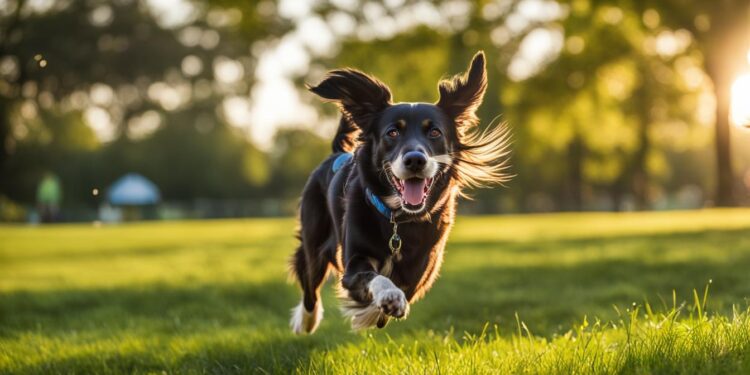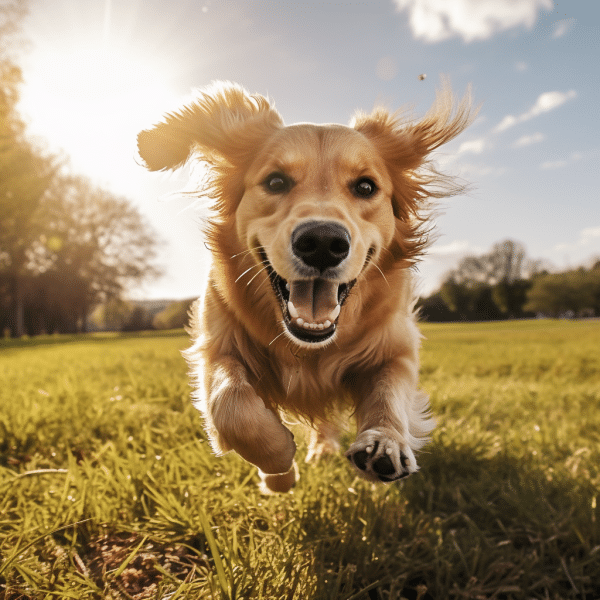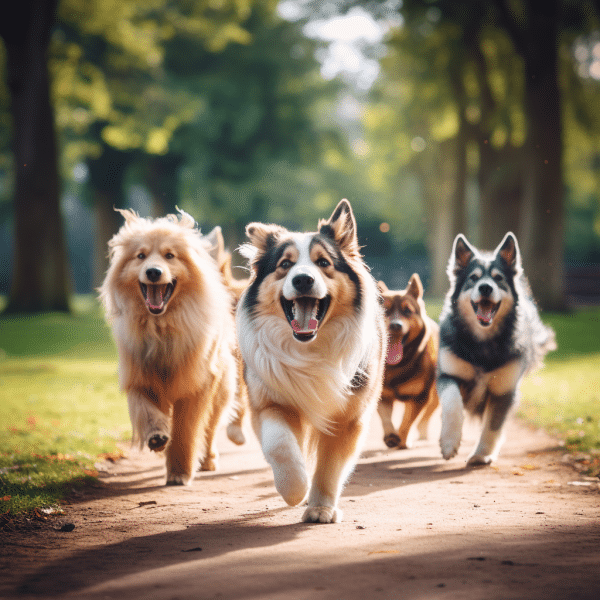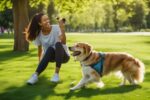Canine Exercise: Promoting Health and Happiness Together

Canine Exercise: Promoting Health and Happiness Regular exercise plays a crucial role in maintaining a dog’s overall health and well-being. Canine exercise is not just about physical fitness, but also mental agility and positive behavior. It is vital for dogs of all ages, breeds, and sizes, as it helps prevent obesity, reduces the risk of certain health issues, and promotes a longer and happier life.
The Health Benefits of Exercise for Dogs
Regular exercise is not only essential for humans but also plays a vital role in maintaining the overall health and well-being of dogs. Exercise has a significant impact on a dog’s cardiovascular and respiratory health, improving oxygen levels, muscle tone, and calorie burning. It helps to keep dogs in shape and reduces the risk of obesity, which can lead to various health issues. In addition to physical benefits, exercise also contributes to the prevention and management of conditions like diabetes and arthritis.
Dogs that engage in regular physical activity have improved cardiovascular fitness, stronger immune systems, and better joint health. Exercise helps to stimulate blood circulation, enhancing the supply of oxygen and nutrients to the body’s tissues and organs. It also promotes the release of endorphins, which are natural mood enhancers that contribute to a dog’s mental well-being. Dogs that exercise regularly are more likely to exhibit positive behavior, including reduced aggression, anxiety, and destructive tendencies.
By incorporating exercise into a dog’s daily routine, pet owners can ensure that their furry companions maintain a healthy weight, have increased stamina, and enjoy an overall higher quality of life. Whether it’s going for a brisk walk, playing fetch, or participating in agility training, it is crucial to provide dogs with appropriate and enjoyable physical activities. By understanding the health benefits of exercise for dogs, pet owners can prioritize their pets’ well-being and contribute to their long-term happiness.
| Benefits of Exercise for Dogs | Summary |
|---|---|
| Improves cardiovascular fitness | Enhances oxygen levels and circulation |
| Strengthens immune system | Reduces the risk of certain health issues |
| Maintains healthy weight | Prevents obesity and associated diseases |
| Supports joint health | Reduces the risk of arthritis and other joint conditions |
| Enhances mental well-being | Reduces anxiety and promotes positive behavior |
How Much Exercise Does a Dog Need?
When it comes to the exercise needs of dogs, there is no one-size-fits-all answer. The amount of exercise a dog requires depends on several factors, including their age, breed, and overall fitness level. While some smaller dogs may be content with short walks, larger and more active breeds may need longer walks or more intense activities to meet their exercise requirements.
To provide a general guideline, adult dogs typically need about 30 minutes to 2 hours of exercise per day. Puppies, on the other hand, have more energy and may require shorter, more frequent exercise sessions throughout the day. It’s important to remember that exercise should be tailored to the individual dog’s needs and capabilities.
For example, a toy breed like a Chihuahua may only need a short walk and some indoor playtime, while a high-energy breed like a Border Collie may benefit from running in the park, playing fetch, or participating in agility training. It’s crucial to observe your dog’s behavior and adjust their exercise routine accordingly to prevent under or over-exercise.
Daily Exercise Recommendations by Breed Size:
| Breed Size | Exercise Recommendation |
|---|---|
| Small (Toy Breeds) | About 30 minutes to 1 hour of exercise |
| Medium (Spaniels, Beagles) | About 1 to 2 hours of exercise |
| Large (Retrievers, Shepherds) | About 1.5 to 3 hours of exercise |
| Giant (Great Danes, Mastiffs) | About 2 to 4 hours of exercise |
Remember to consult with your veterinarian to determine the ideal duration and intensity of exercise for your specific dog, as individual needs may vary.
Outdoor Exercise for Dogs
Outdoor exercise provides dogs with the opportunity to indulge in physical activity while enjoying the fresh air and natural surroundings. Engaging in outdoor activities not only helps to fulfill their exercise needs but also provides mental stimulation and enrichment. There are various options for outdoor exercise that cater to different breeds, sizes, and energy levels.
Popular Outdoor Activities for Dogs
1. Hikes: Taking your dog on a hike is a fantastic way to explore nature together. Choose trails suitable for dogs, and don’t forget to bring water and snacks for both of you. Hiking allows dogs to exert energy while experiencing new scents and sights.
2. Runs: For high-energy breeds, running is an excellent way to burn off excess energy. Whether it’s a jog around the neighborhood or a jog on designated dog trails, running helps to keep dogs physically fit and mentally stimulated.
3. Swimming: Many dogs love swimming, and it is a low-impact activity that is easy on their joints. Find dog-friendly swimming areas like lakes or beaches, and ensure your dog is comfortable in the water. Swimming is a great exercise for dogs, especially during hot summer months.
4. Fetch: Playing fetch is a classic outdoor activity for dogs. It allows them to sprint and chase after a ball or Frisbee, providing a high-intensity workout. Find an open space, like a park or backyard, and engage in a fun game of fetch with your furry friend.
| Activity | Benefits |
|---|---|
| Hikes | Exploring nature, mental stimulation |
| Runs | Burns energy, improves cardiovascular health |
| Swimming | Low-impact exercise, joint-friendly |
| Fetch | High-intensity workout, improves agility |
“Outdoor exercise allows dogs to engage in physical exercise while enjoying the natural environment, promoting their overall physical and mental well-being.” – Dr. Jane Thompson, Veterinarian
Remember to consider your dog’s fitness level and any specific health conditions when engaging in outdoor exercise. Always bring water, poop bags, and any necessary safety equipment. It’s also essential to be mindful of the weather conditions and adjust the intensity and duration of the exercise accordingly. Consulting with your veterinarian can help determine the most suitable outdoor activities for your dog.
Indoor Exercise for Dogs
When the weather doesn’t allow for outdoor activities, or when living in an apartment with limited space, it’s important to find ways to keep dogs physically and mentally stimulated indoors. Here are some indoor activities that can help keep dogs active and entertained:
1. Tug of War
Tug of War is a popular game that dogs enjoy and can provide a good workout. It helps build strength in their jaws and provides mental stimulation. Use a sturdy rope or tug toy and engage in a friendly game of tug. Remember to establish boundaries and ensure that your dog understands the rules of the game.
2. Indoor Fetch
Even indoors, dogs can enjoy a game of fetch. Opt for soft and lightweight toys that won’t cause damage to your home. Clear a space and throw the toy, encouraging your dog to retrieve it. This game helps improve agility and provides a good cardiovascular workout.
3. Hide and Seek
Engage your dog’s natural sense of smell and mental agility by playing a game of hide and seek. Start by hiding treats or toys in various locations around the house and encourage your dog to find them. This activity provides mental stimulation and keeps dogs active while indoors.
Remember to consult with a veterinarian before starting any new exercise routine, especially if your dog has any health concerns or limitations. Each dog has different exercise needs, so it’s important to tailor the activities to suit their age, size, and energy level. By incorporating indoor exercises into their routine, you can ensure that your furry friend remains happy, healthy, and active all year round.
Health Issues Caused by Lack of Exercise
A sedentary lifestyle can have detrimental effects on a dog’s health. Without regular exercise, dogs are at an increased risk of developing obesity, which can lead to a range of health issues. Obesity in dogs can contribute to conditions such as diabetes, arthritis, and cardiovascular problems. It puts extra strain on their joints and organs, reducing their quality of life and potentially shortening their lifespan.
Regular exercise not only helps dogs maintain a healthy weight but also supports their joint health. Physical activity helps strengthen muscles and improves flexibility, reducing the risk of developing arthritis and other joint-related problems. Exercise also promotes better cardiovascular health as it stimulates the heart and circulatory system, increasing oxygen levels in the body.
Additionally, a lack of exercise can have negative impacts on a dog’s mental well-being. Dogs that do not engage in regular physical activity may become bored, restless, and prone to destructive behaviors. Exercise provides mental stimulation and helps release pent-up energy, keeping dogs mentally sharp and content.
“A sedentary lifestyle can have detrimental effects on a dog’s health, leading to obesity, joint problems, and behavioral issues.”
To prevent these health issues caused by a lack of exercise, it is vital for dog owners to prioritize regular physical activity. By providing dogs with opportunities for outdoor and indoor exercise, owners can contribute to their pets’ overall well-being and enhance their quality of life.
| Health Risks of No Exercise for Dogs | Consequences of Sedentary Lifestyle |
|---|---|
| Obesity | Reduced quality of life |
| Diabetes | Increased risk of health issues |
| Arthritis | Muscle weakness and stiffness |
| Cardiovascular problems | Limited mobility |
| Behavioral issues | Restlessness and boredom |
Motivating Dogs to Exercise
Motivating dogs to exercise is essential for ensuring their overall health and well-being. Just like humans, dogs can sometimes need a little extra encouragement to stay active and engaged. Fortunately, there are several effective techniques that dog owners can employ to motivate their furry friends and make exercise a fun and enjoyable experience.
1. Incorporate positive reinforcement:
Positive reinforcement is a powerful tool in motivating dogs to exercise. By rewarding desirable behavior with treats, praise, or playtime, you can create a positive association with physical activity. For example, offer a treat or engage in a favorite game after a successful exercise session. This not only encourages dogs to participate but also reinforces the idea that exercise is a rewarding and enjoyable activity.
2. Tailor the exercise routine to their preferences:
Understanding your dog’s preferences and tailoring the exercise routine accordingly can significantly boost their motivation. Some dogs may enjoy brisk walks, while others may prefer activities like agility training or playing fetch. Experiment with different forms of exercise to find what resonates most with your canine companion. By incorporating activities they genuinely enjoy, you can keep them enthusiastic and engaged.
3. Make it a social experience:
Dogs are social animals and often thrive on interaction with their owners and fellow canines. Consider making exercise a social experience by involving other dogs or organizing playdates. The presence of other dogs can be highly motivating and encourage your furry friend to stay active. Additionally, participating in activities together with your dog strengthens the bond between you and provides an opportunity for quality time spent together.
| Technique | Description |
|---|---|
| Positive reinforcement | Rewarding desirable behavior with treats, praise, or playtime to create a positive association with exercise. |
| Tailored exercise routine | Adapting the exercise routine to your dog’s preferences and incorporating activities they enjoy the most. |
| Social experience | Involving other dogs or organizing playdates to make exercise a fun and interactive experience. |
Motivating dogs to exercise is crucial for their physical and mental well-being. By using positive reinforcement, tailoring the exercise routine to their preferences, and making it a social experience, you can ensure that your canine companion stays active and healthy. Remember to consult with your veterinarian to determine the appropriate exercise regimen for your dog based on their age, breed, and overall health condition.
Section 8: Safe Exercise Practices for Dogs
When it comes to exercise for dogs, ensuring their safety should always be a top priority. By following some simple guidelines, you can help prevent exercise-related injuries and keep your furry friend healthy and happy.
Gradual Conditioning
Just like humans, dogs need time to build up their endurance and fitness levels. When starting a new exercise routine, it’s important to begin with shorter sessions and gradually increase the duration and intensity over time. This allows dogs to adapt to the physical demands and reduces the risk of strain or injury.
Monitor Signs of Fatigue
While it’s important to challenge dogs during exercise, it’s equally important to be aware of their limits. Keep an eye out for signs of fatigue such as excessive panting, lagging behind, or seeking shade. If your dog shows any signs of exhaustion, it’s essential to allow them to rest and recover before continuing or seeking veterinary attention if necessary.
Consider Weather Conditions
Extreme temperatures can have a significant impact on a dog’s ability to exercise safely. On hot days, avoid exercising your dog during the peak heat hours and opt for early morning or evening sessions when temperatures are cooler. During cold weather, ensure your dog is adequately protected with appropriate gear to prevent hypothermia or paw injuries from ice and salt on the ground.
Proper Warm-Up and Cool-Down
Similar to humans, dogs benefit from a good warm-up and cool-down routine. Before starting any intense exercise, take a few minutes to allow your dog to stretch their muscles and loosen up. After exercise, allow them to cool down gradually by reducing the intensity of the activity and offering water for hydration.
Preventing Overexertion
While some dogs may be eager to keep going, it’s important to recognize when they’ve had enough. Certain breeds, such as brachycephalic (short-nosed) dogs, are more susceptible to overheating and breathing difficulties. Pay attention to your dog’s breathing rate and overall physical comfort, and adjust the intensity and duration of exercise accordingly.
| Exercise Safety Tips |
|---|
| Gradually increase exercise duration and intensity. |
| Monitor signs of fatigue and allow for rest when needed. |
| Avoid exercising in extreme weather conditions. |
| Implement proper warm-up and cool-down routines. |
| Prevent overexertion, particularly for brachycephalic breeds. |
By prioritizing your dog’s safety during exercise, you can help prevent injuries and ensure a positive and enjoyable experience for both you and your canine companion.
Conclusion
Regular exercise is crucial for every dog’s physical and mental well-being. It plays a vital role in maintaining their overall health and happiness. By prioritizing exercise, dog owners can significantly contribute to their pets’ long and healthy lives.
Exercise helps dogs maintain a healthy weight, preventing obesity and reducing the risk of various health issues. It promotes cardiovascular and respiratory health, improving oxygen levels and muscle tone. Keeping dogs active also supports joint health and helps prevent chronic conditions like diabetes and arthritis.
Engaging in both outdoor and indoor activities provides dogs with the necessary physical and mental stimulation. Whether it’s going for runs, hikes, swimming, or playing interactive games indoors, exercise contributes to their overall fitness and positive behavior. It is crucial to tailor the exercise routine to the dog’s preferences and use positive reinforcement to keep them motivated.
By implementing safe exercise practices such as gradual conditioning and monitoring the dog’s response, owners can prevent exercise-related injuries. Considering factors like weather conditions and adjusting the intensity accordingly ensures a safe and enjoyable exercise experience.
FAQ
Why is exercise important for dogs?
Exercise is crucial for a dog’s overall health and well-being. It helps maintain physical fitness, mental agility, and positive behavior. Regular exercise prevents obesity, reduces the risk of certain health issues, and promotes a longer and happier life.
How much exercise does a dog need?
The amount of exercise a dog needs depends on factors such as age, breed, and overall fitness level. Smaller dogs may only require short walks, while larger and more active dogs may benefit from longer walks or more intense activities. It is important to provide dogs with multiple exercise sessions throughout the day.
What outdoor activities can I do with my dog?
There are various options for outdoor exercise, including hikes, runs, swimming, playing fetch, and agility training. These activities allow dogs to engage in physical exercise while enjoying the outdoors. It is important to ensure a safe and controlled environment for outdoor exercise.
What indoor activities can I do with my dog?
When outdoor exercise is not possible, you can still keep your dog active indoors. Activities like tug of war and indoor ball games provide mental and physical stimulation. It is important to choose activities that suit the available space and provide adequate exercise for dogs.
What are the health risks of not exercising my dog?
A lack of exercise can lead to obesity, which is a significant health problem for dogs. Obesity increases the risk of various diseases, including diabetes and arthritis. Regular exercise helps dogs maintain a healthy weight, supports joint health, and reduces the chances of developing chronic conditions.
How can I motivate my dog to exercise?
Different dogs may be motivated by different things. Some dogs respond well to food rewards and interactive games, while others may enjoy the presence and engagement of their owners during exercise. Tailoring the exercise routine to the dog’s preferences and using positive reinforcement can help motivate them to stay active.
How can I ensure my dog exercises safely?
It is important to ensure that dogs are not overexerted during exercise. Gradual conditioning and monitoring the dog’s response to exercise can help prevent injuries. Also, considering factors like weather conditions and adjusting exercise intensity accordingly is crucial. Providing a safe environment for exercise is essential.
Why is exercise important for dogs?
Exercise is crucial for a dog’s overall health and well-being. It helps maintain physical fitness, mental agility, and positive behavior. Regular exercise prevents obesity, reduces the risk of certain health issues, and promotes a longer and happier life.








